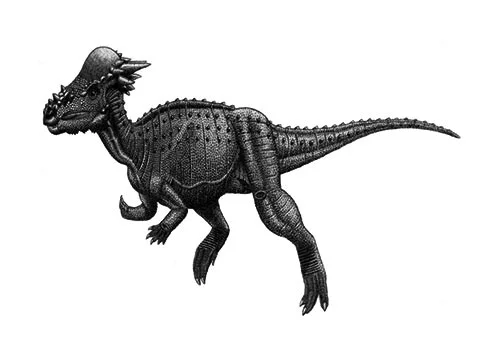Pachycephalosaurus (thick headed lizard)

Pak-ee-sef-ah-low-sore-us
Barnum Brown & Erich Maren Schlaikjer - 1943
Herbivore/Omnivore
Estimated up to 4.5 meters long
Euornithopod
P. wyomingensis (type)
USA
Late Cretaceous, 70-65 million years ago
Pachycephalosaurus Facts
Pachycephalosaurus is a genus of herbivorous dinosaur that lived during the Late Cretaceous period, approximately 70-65 million years ago. The name Pachycephalosaurus means “thick-headed lizard”, referring to the thick bony dome on its skull.
Pachycephalosaurus was a relatively large dinosaur, reaching lengths of up to 4.5 meters (15 feet) and weighing around 450 kg (1,000 lbs). It had a bulky body with short, powerful limbs, and a long, stiff tail that helped it maintain balance.
The most distinctive feature of Pachycephalosaurus was the thick bony dome on its skull, which could be up to 25 centimeters (10 inches) thick. This dome was composed of solid bone and may have been used for head-butting during intra-species combat or courtship displays. Pachycephalosaurus may have also used its thick skull to protect itself from predators.
Pachycephalosaurus was an herbivore, feeding on tough vegetation such as ferns and horsetails. Its teeth were small and pointed, suggesting that it had a selective feeding behavior and may have eaten more than just plants. Pachycephalosaurus likely lived in herds and may have been able to defend itself from predators by using its thick skull as a weapon.
The first specimen of Pachycephalosaurus was discovered in the late 19th century, and since then, many more specimens have been found throughout North America. These fossils have helped scientists understand the anatomy, behavior, and ecology of this unique dinosaur.
In conclusion, Pachycephalosaurus is a genus of herbivorous dinosaur that lived during the Late Cretaceous period. Its name means “thick-headed lizard”, referring to the thick bony dome on its skull. Pachycephalosaurus was a relatively large dinosaur that likely lived in herds and used its thick skull for head-butting and protection. It was an herbivore that may have had a selective feeding behavior and could defend itself from predators. The discovery of Pachycephalosaurus fossils has helped scientists understand more about the biology and behavior of these fascinating dinosaurs.



